Math 2280 - Assignment 3 Solutions - Differential Equations, Fall 2013
VerifiedAdded on 2023/01/13
|19
|3021
|1
Homework Assignment
AI Summary
This document provides detailed solutions for Math 2280 Assignment 3, focusing on differential equations and numerical approximation techniques. The assignment covers several key concepts, including acceleration-velocity models where the movement of objects is analyzed under different resistance conditions, such as air resistance proportional to velocity or its square. The solutions involve setting up and solving separable differential equations to determine velocity and position functions. Furthermore, the assignment explores Euler's method for approximating solutions to initial value problems, comparing the accuracy of approximations with different step sizes. Problems include calculating the time it takes for a Maserati to accelerate to a certain speed, analyzing the distance a body travels under resistance, and approximating solutions to differential equations using Euler's method. The solutions are presented step-by-step, showing the application of calculus principles to real-world scenarios.
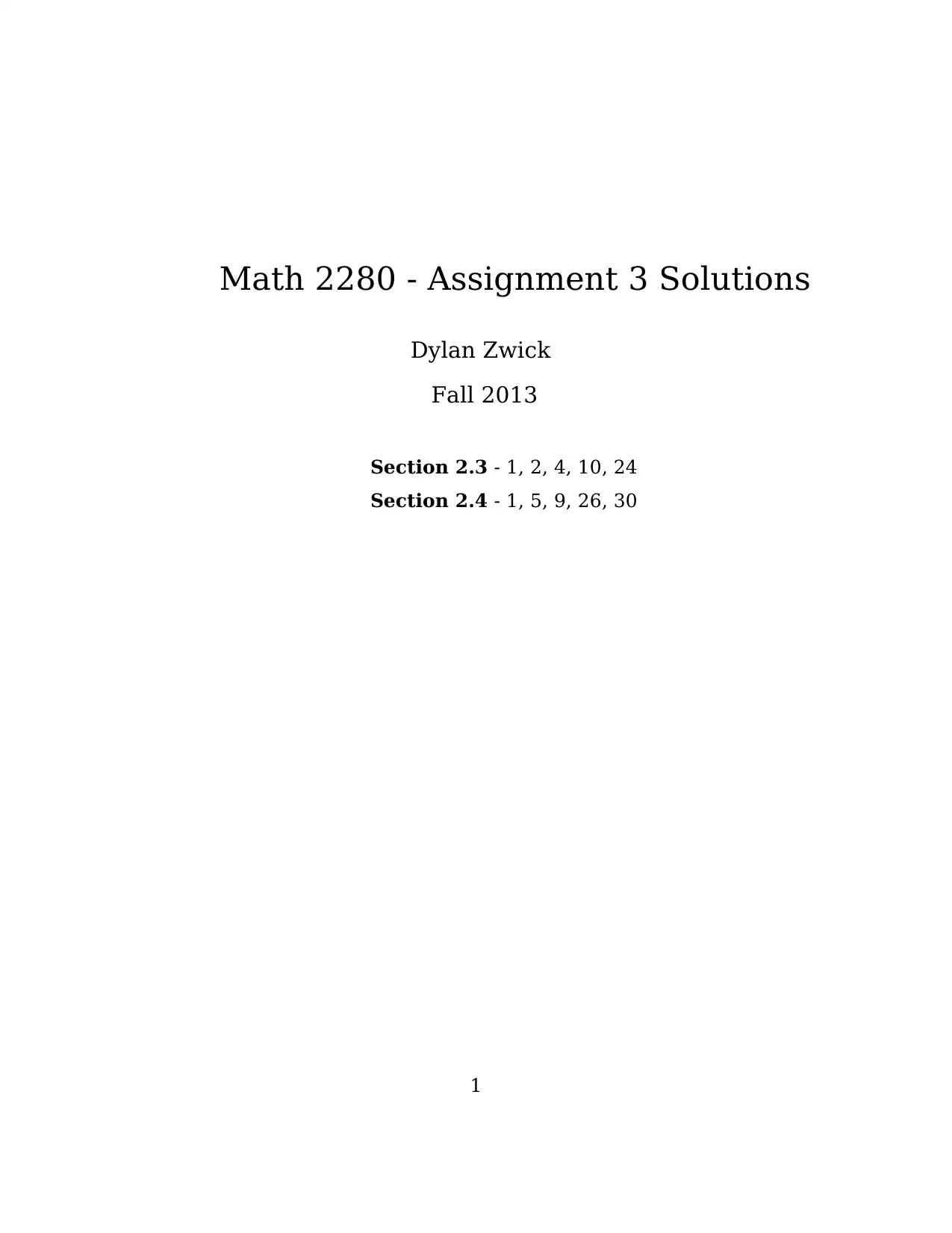
Math 2280 - Assignment 3 Solutions
Dylan Zwick
Fall 2013
Section 2.3 - 1, 2, 4, 10, 24
Section 2.4 - 1, 5, 9, 26, 30
1
Dylan Zwick
Fall 2013
Section 2.3 - 1, 2, 4, 10, 24
Section 2.4 - 1, 5, 9, 26, 30
1
Paraphrase This Document
Need a fresh take? Get an instant paraphrase of this document with our AI Paraphraser
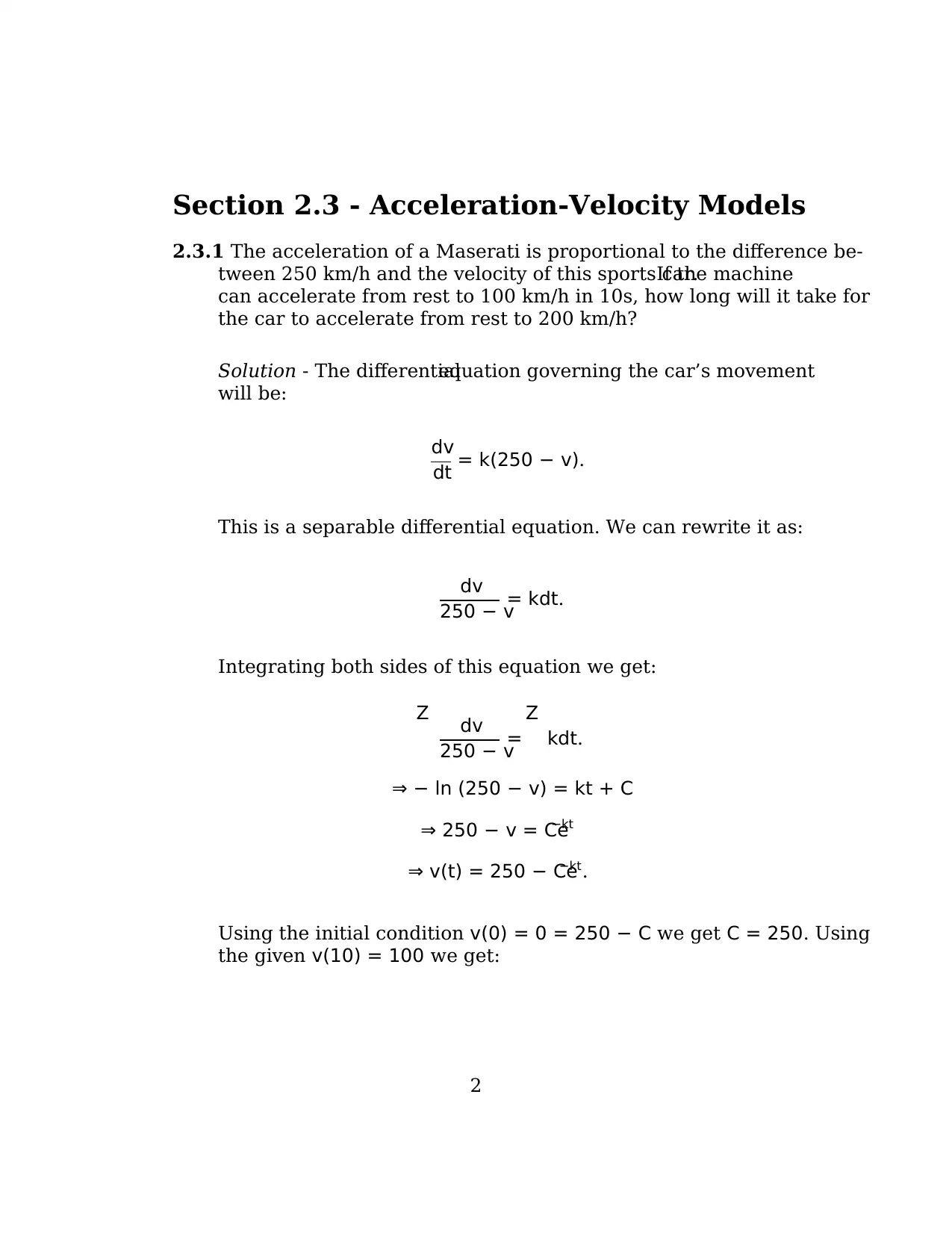
Section 2.3 - Acceleration-Velocity Models
2.3.1 The acceleration of a Maserati is proportional to the difference be-
tween 250 km/h and the velocity of this sports car.If the machine
can accelerate from rest to 100 km/h in 10s, how long will it take for
the car to accelerate from rest to 200 km/h?
Solution - The differentialequation governing the car’s movement
will be:
dv
dt = k(250 − v).
This is a separable differential equation. We can rewrite it as:
dv
250 − v
= kdt.
Integrating both sides of this equation we get:
Z dv
250 − v
=
Z
kdt.
⇒ − ln (250 − v) = kt + C
⇒ 250 − v = Ce−kt
⇒ v(t) = 250 − Ce−kt.
Using the initial condition v(0) = 0 = 250 − C we get C = 250. Using
the given v(10) = 100 we get:
2
2.3.1 The acceleration of a Maserati is proportional to the difference be-
tween 250 km/h and the velocity of this sports car.If the machine
can accelerate from rest to 100 km/h in 10s, how long will it take for
the car to accelerate from rest to 200 km/h?
Solution - The differentialequation governing the car’s movement
will be:
dv
dt = k(250 − v).
This is a separable differential equation. We can rewrite it as:
dv
250 − v
= kdt.
Integrating both sides of this equation we get:
Z dv
250 − v
=
Z
kdt.
⇒ − ln (250 − v) = kt + C
⇒ 250 − v = Ce−kt
⇒ v(t) = 250 − Ce−kt.
Using the initial condition v(0) = 0 = 250 − C we get C = 250. Using
the given v(10) = 100 we get:
2
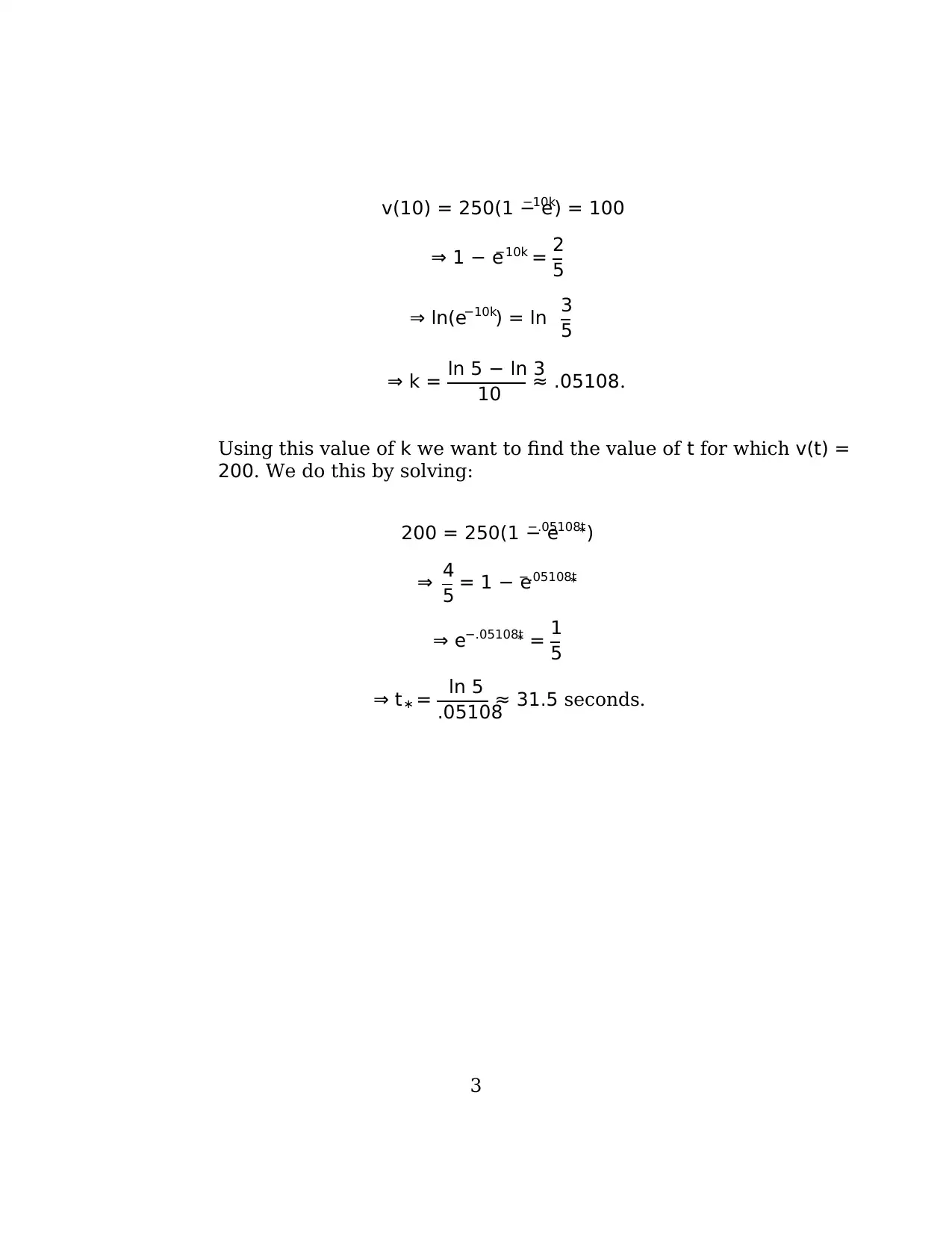
v(10) = 250(1 − e−10k) = 100
⇒ 1 − e−10k = 2
5
⇒ ln(e−10k) = ln 3
5
⇒ k = ln 5 − ln 3
10 ≈ .05108.
Using this value of k we want to find the value of t for which v(t) =
200. We do this by solving:
200 = 250(1 − e−.05108t∗)
⇒ 4
5 = 1 − e−.05108t∗
⇒ e−.05108t∗ = 1
5
⇒ t∗ = ln 5
.05108
≈ 31.5 seconds.
3
⇒ 1 − e−10k = 2
5
⇒ ln(e−10k) = ln 3
5
⇒ k = ln 5 − ln 3
10 ≈ .05108.
Using this value of k we want to find the value of t for which v(t) =
200. We do this by solving:
200 = 250(1 − e−.05108t∗)
⇒ 4
5 = 1 − e−.05108t∗
⇒ e−.05108t∗ = 1
5
⇒ t∗ = ln 5
.05108
≈ 31.5 seconds.
3
⊘ This is a preview!⊘
Do you want full access?
Subscribe today to unlock all pages.

Trusted by 1+ million students worldwide
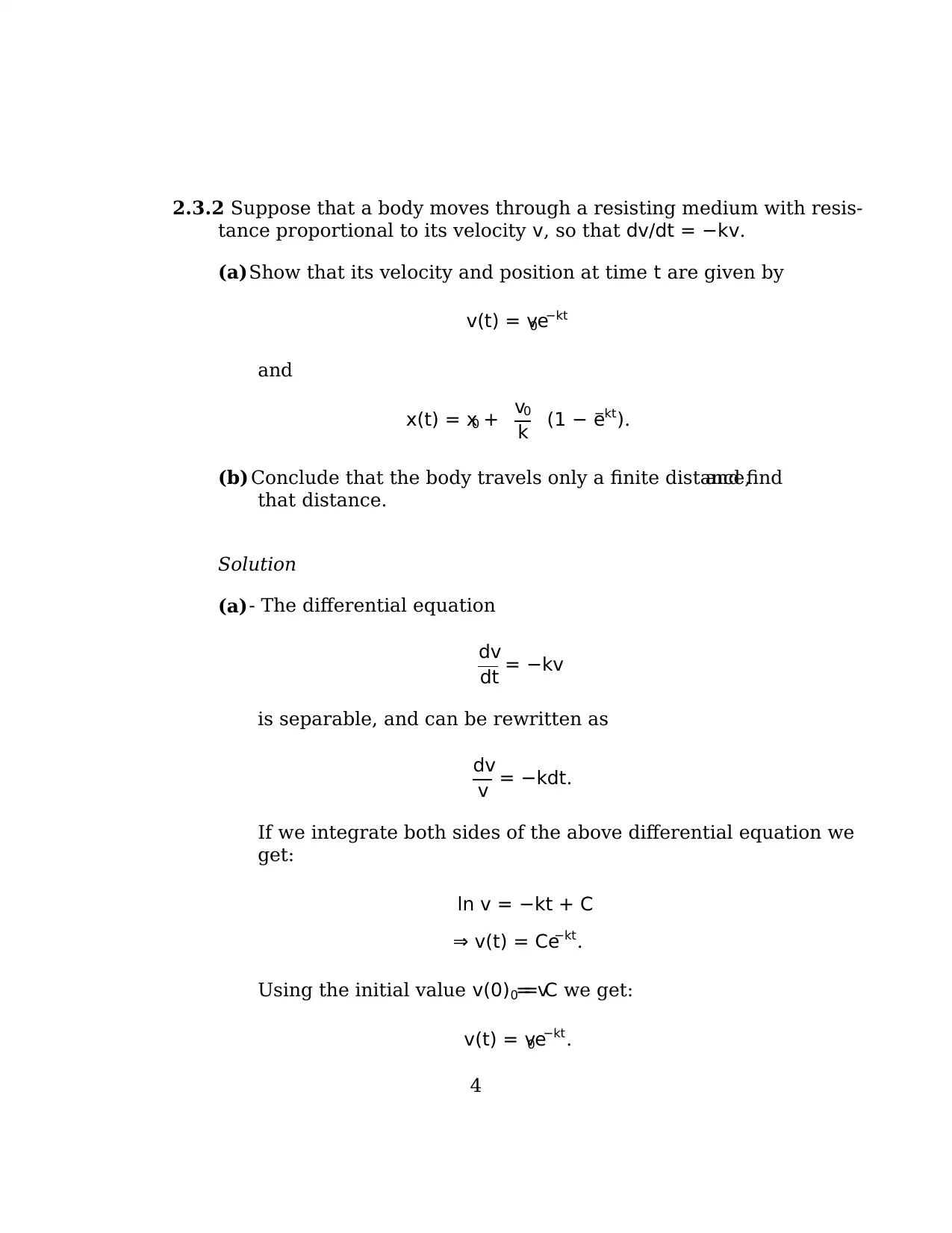
2.3.2 Suppose that a body moves through a resisting medium with resis-
tance proportional to its velocity v, so that dv/dt = −kv.
(a)Show that its velocity and position at time t are given by
v(t) = v0e−kt
and
x(t) = x0 + v0
k (1 − e−kt).
(b) Conclude that the body travels only a finite distance,and find
that distance.
Solution
(a)- The differential equation
dv
dt = −kv
is separable, and can be rewritten as
dv
v = −kdt.
If we integrate both sides of the above differential equation we
get:
ln v = −kt + C
⇒ v(t) = Ce−kt.
Using the initial value v(0) = v0 = C we get:
v(t) = v0e−kt.
4
tance proportional to its velocity v, so that dv/dt = −kv.
(a)Show that its velocity and position at time t are given by
v(t) = v0e−kt
and
x(t) = x0 + v0
k (1 − e−kt).
(b) Conclude that the body travels only a finite distance,and find
that distance.
Solution
(a)- The differential equation
dv
dt = −kv
is separable, and can be rewritten as
dv
v = −kdt.
If we integrate both sides of the above differential equation we
get:
ln v = −kt + C
⇒ v(t) = Ce−kt.
Using the initial value v(0) = v0 = C we get:
v(t) = v0e−kt.
4
Paraphrase This Document
Need a fresh take? Get an instant paraphrase of this document with our AI Paraphraser
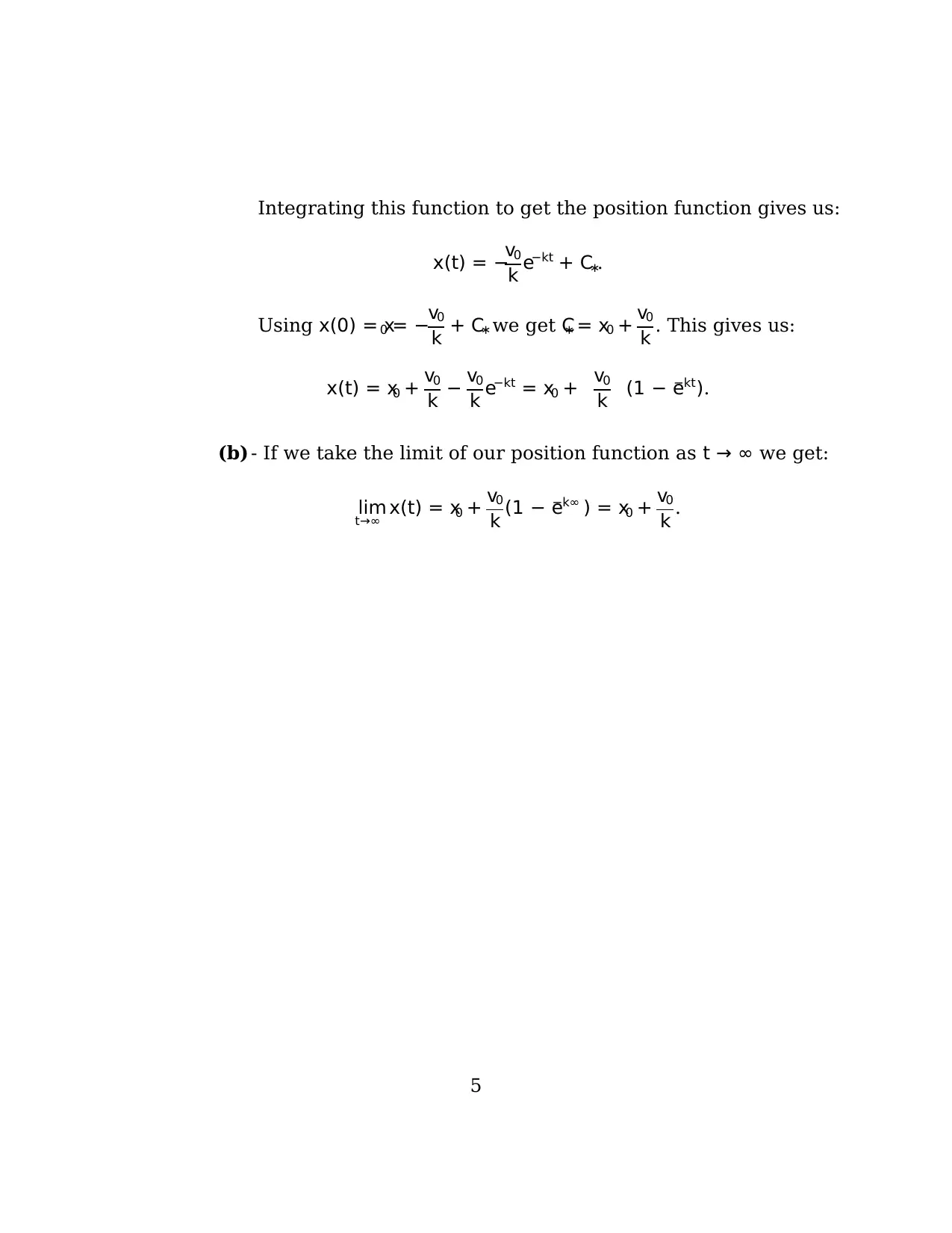
Integrating this function to get the position function gives us:
x(t) = −
v0
k e−kt + C∗.
Using x(0) = x0 = −v0
k + C∗ we get C∗ = x0 + v0
k . This gives us:
x(t) = x0 + v0
k − v0
k e−kt = x0 + v0
k (1 − e−kt).
(b) - If we take the limit of our position function as t → ∞ we get:
lim
t→∞ x(t) = x0 + v0
k (1 − e−k∞ ) = x0 + v0
k .
5
x(t) = −
v0
k e−kt + C∗.
Using x(0) = x0 = −v0
k + C∗ we get C∗ = x0 + v0
k . This gives us:
x(t) = x0 + v0
k − v0
k e−kt = x0 + v0
k (1 − e−kt).
(b) - If we take the limit of our position function as t → ∞ we get:
lim
t→∞ x(t) = x0 + v0
k (1 − e−k∞ ) = x0 + v0
k .
5
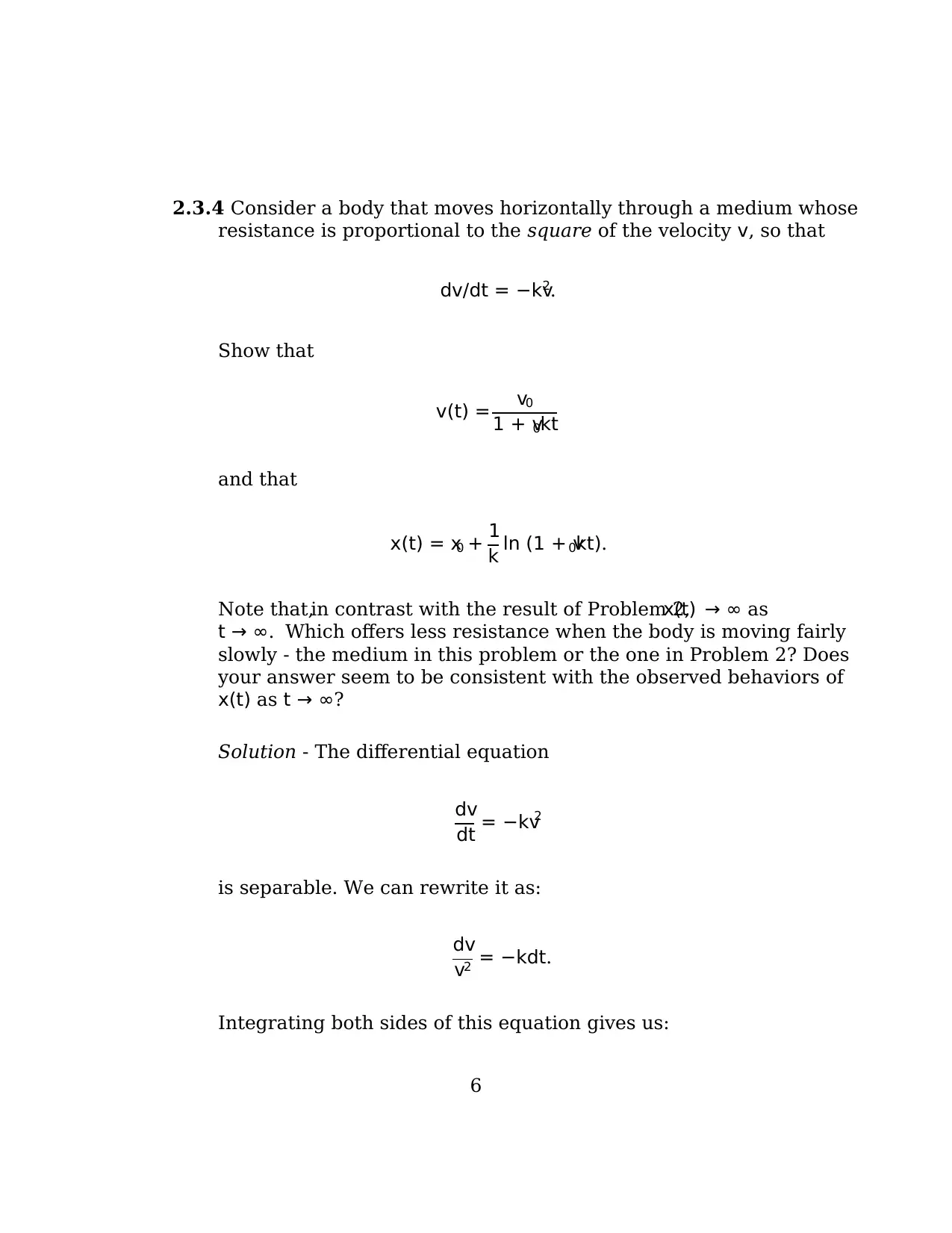
2.3.4 Consider a body that moves horizontally through a medium whose
resistance is proportional to the square of the velocity v, so that
dv/dt = −kv2.
Show that
v(t) = v0
1 + v0kt
and that
x(t) = x0 + 1
k ln (1 + v0kt).
Note that,in contrast with the result of Problem 2,x(t) → ∞ as
t → ∞. Which offers less resistance when the body is moving fairly
slowly - the medium in this problem or the one in Problem 2? Does
your answer seem to be consistent with the observed behaviors of
x(t) as t → ∞?
Solution - The differential equation
dv
dt = −kv2
is separable. We can rewrite it as:
dv
v2 = −kdt.
Integrating both sides of this equation gives us:
6
resistance is proportional to the square of the velocity v, so that
dv/dt = −kv2.
Show that
v(t) = v0
1 + v0kt
and that
x(t) = x0 + 1
k ln (1 + v0kt).
Note that,in contrast with the result of Problem 2,x(t) → ∞ as
t → ∞. Which offers less resistance when the body is moving fairly
slowly - the medium in this problem or the one in Problem 2? Does
your answer seem to be consistent with the observed behaviors of
x(t) as t → ∞?
Solution - The differential equation
dv
dt = −kv2
is separable. We can rewrite it as:
dv
v2 = −kdt.
Integrating both sides of this equation gives us:
6
⊘ This is a preview!⊘
Do you want full access?
Subscribe today to unlock all pages.

Trusted by 1+ million students worldwide
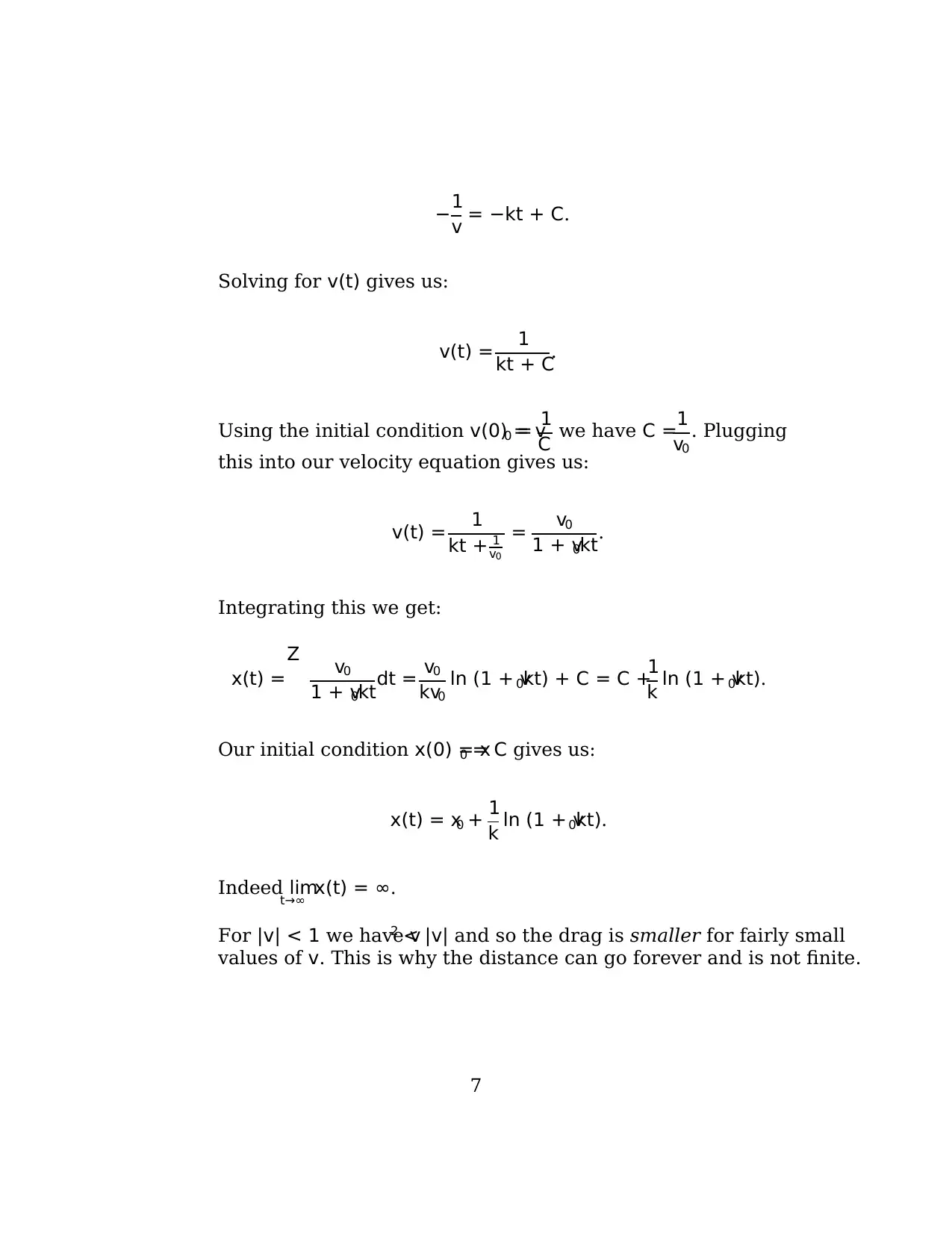
−1
v = −kt + C.
Solving for v(t) gives us:
v(t) = 1
kt + C.
Using the initial condition v(0) = v0 = 1
C we have C =1
v0
. Plugging
this into our velocity equation gives us:
v(t) = 1
kt + 1
v0
= v0
1 + v0kt.
Integrating this we get:
x(t) =
Z v0
1 + v0ktdt = v0
kv0
ln (1 + v0kt) + C = C +
1
k ln (1 + v0kt).
Our initial condition x(0) = x0 = C gives us:
x(t) = x0 + 1
k ln (1 + v0kt).
Indeed lim
t→∞ x(t) = ∞.
For |v| < 1 we have v2 < |v| and so the drag is smaller for fairly small
values of v. This is why the distance can go forever and is not finite.
7
v = −kt + C.
Solving for v(t) gives us:
v(t) = 1
kt + C.
Using the initial condition v(0) = v0 = 1
C we have C =1
v0
. Plugging
this into our velocity equation gives us:
v(t) = 1
kt + 1
v0
= v0
1 + v0kt.
Integrating this we get:
x(t) =
Z v0
1 + v0ktdt = v0
kv0
ln (1 + v0kt) + C = C +
1
k ln (1 + v0kt).
Our initial condition x(0) = x0 = C gives us:
x(t) = x0 + 1
k ln (1 + v0kt).
Indeed lim
t→∞ x(t) = ∞.
For |v| < 1 we have v2 < |v| and so the drag is smaller for fairly small
values of v. This is why the distance can go forever and is not finite.
7
Paraphrase This Document
Need a fresh take? Get an instant paraphrase of this document with our AI Paraphraser
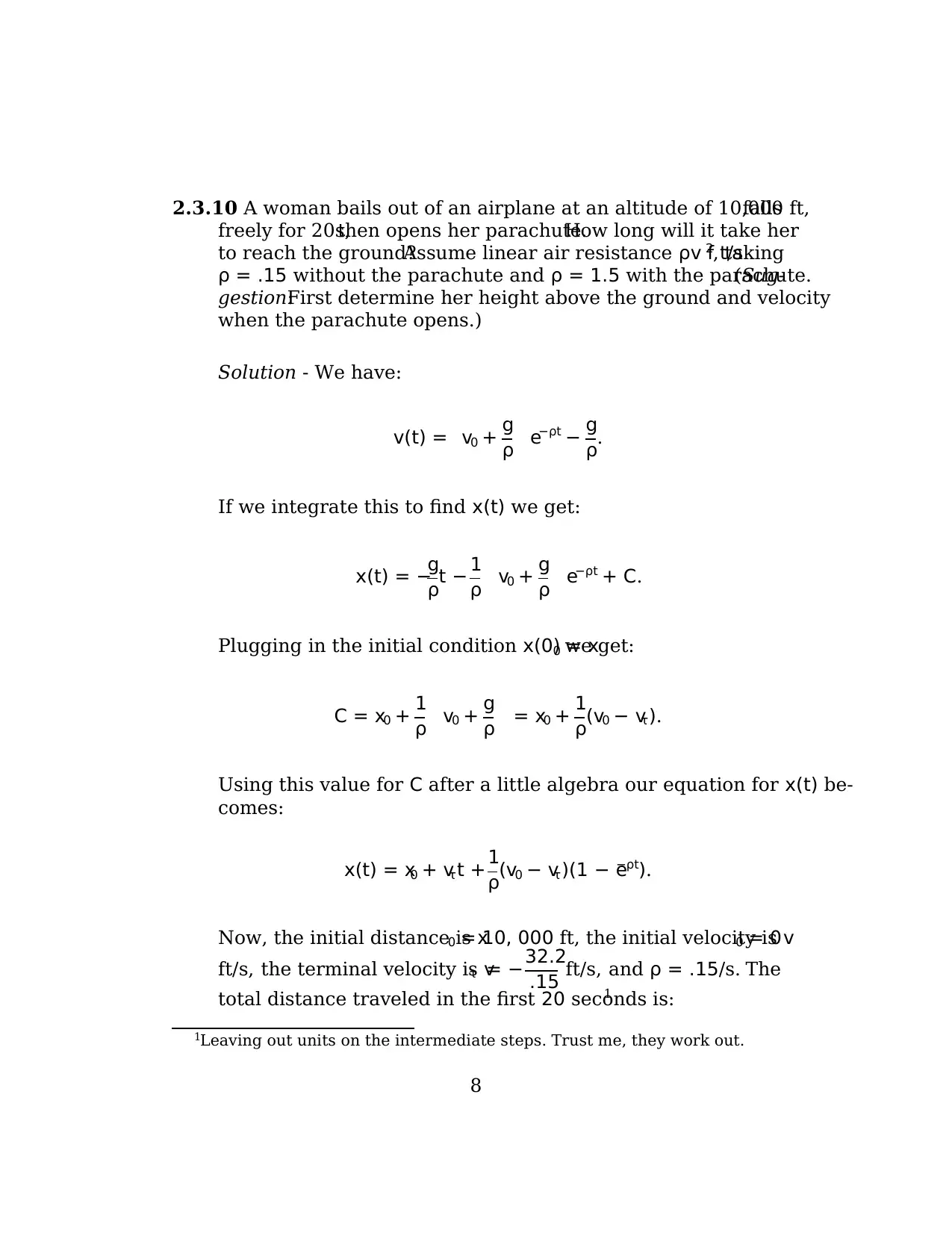
2.3.10 A woman bails out of an airplane at an altitude of 10,000 ft,falls
freely for 20s,then opens her parachute.How long will it take her
to reach the ground?Assume linear air resistance ρv f t/s2, taking
ρ = .15 without the parachute and ρ = 1.5 with the parachute.(Sug-
gestion:First determine her height above the ground and velocity
when the parachute opens.)
Solution - We have:
v(t) = v0 + g
ρ e−ρt − g
ρ.
If we integrate this to find x(t) we get:
x(t) = −
g
ρt − 1
ρ v0 + g
ρ e−ρt + C.
Plugging in the initial condition x(0) = x0 we get:
C = x0 + 1
ρ v0 + g
ρ = x0 + 1
ρ(v0 − vτ).
Using this value for C after a little algebra our equation for x(t) be-
comes:
x(t) = x0 + vτt + 1
ρ(v0 − vτ)(1 − e−ρt).
Now, the initial distance is x0 = 10, 000 ft, the initial velocity is v0 = 0
ft/s, the terminal velocity is vτ = −32.2
.15 ft/s, and ρ = .15/s. The
total distance traveled in the first 20 seconds is:1
1Leaving out units on the intermediate steps. Trust me, they work out.
8
freely for 20s,then opens her parachute.How long will it take her
to reach the ground?Assume linear air resistance ρv f t/s2, taking
ρ = .15 without the parachute and ρ = 1.5 with the parachute.(Sug-
gestion:First determine her height above the ground and velocity
when the parachute opens.)
Solution - We have:
v(t) = v0 + g
ρ e−ρt − g
ρ.
If we integrate this to find x(t) we get:
x(t) = −
g
ρt − 1
ρ v0 + g
ρ e−ρt + C.
Plugging in the initial condition x(0) = x0 we get:
C = x0 + 1
ρ v0 + g
ρ = x0 + 1
ρ(v0 − vτ).
Using this value for C after a little algebra our equation for x(t) be-
comes:
x(t) = x0 + vτt + 1
ρ(v0 − vτ)(1 − e−ρt).
Now, the initial distance is x0 = 10, 000 ft, the initial velocity is v0 = 0
ft/s, the terminal velocity is vτ = −32.2
.15 ft/s, and ρ = .15/s. The
total distance traveled in the first 20 seconds is:1
1Leaving out units on the intermediate steps. Trust me, they work out.
8
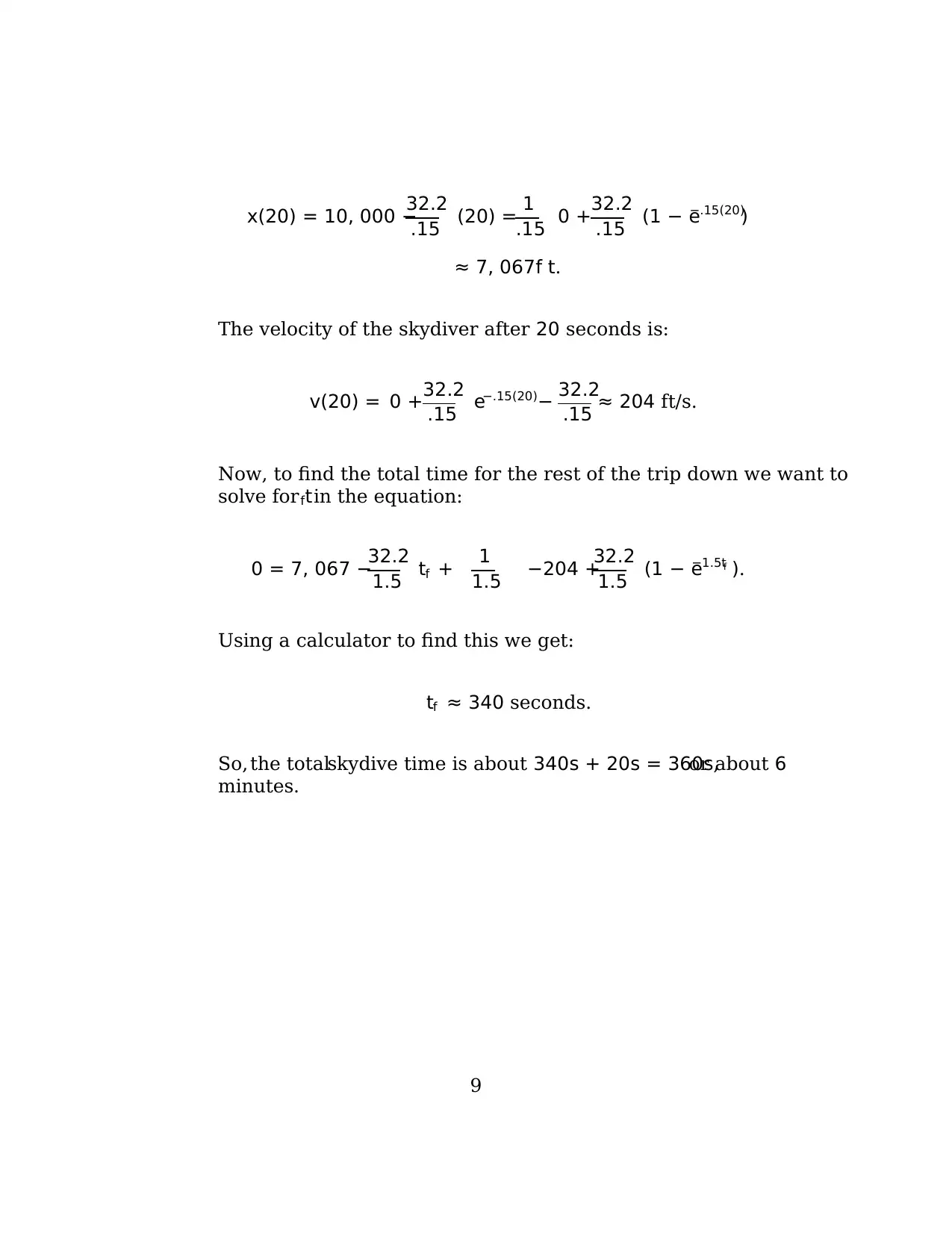
x(20) = 10, 000 −
32.2
.15 (20) = 1
.15 0 +32.2
.15 (1 − e−.15(20)
)
≈ 7, 067f t.
The velocity of the skydiver after 20 seconds is:
v(20) = 0 +32.2
.15 e−.15(20)− 32.2
.15 ≈ 204 ft/s.
Now, to find the total time for the rest of the trip down we want to
solve for tf in the equation:
0 = 7, 067 −
32.2
1.5 tf + 1
1.5 −204 +
32.2
1.5 (1 − e−1.5tf ).
Using a calculator to find this we get:
tf ≈ 340 seconds.
So, the totalskydive time is about 340s + 20s = 360s,or about 6
minutes.
9
32.2
.15 (20) = 1
.15 0 +32.2
.15 (1 − e−.15(20)
)
≈ 7, 067f t.
The velocity of the skydiver after 20 seconds is:
v(20) = 0 +32.2
.15 e−.15(20)− 32.2
.15 ≈ 204 ft/s.
Now, to find the total time for the rest of the trip down we want to
solve for tf in the equation:
0 = 7, 067 −
32.2
1.5 tf + 1
1.5 −204 +
32.2
1.5 (1 − e−1.5tf ).
Using a calculator to find this we get:
tf ≈ 340 seconds.
So, the totalskydive time is about 340s + 20s = 360s,or about 6
minutes.
9
⊘ This is a preview!⊘
Do you want full access?
Subscribe today to unlock all pages.

Trusted by 1+ million students worldwide
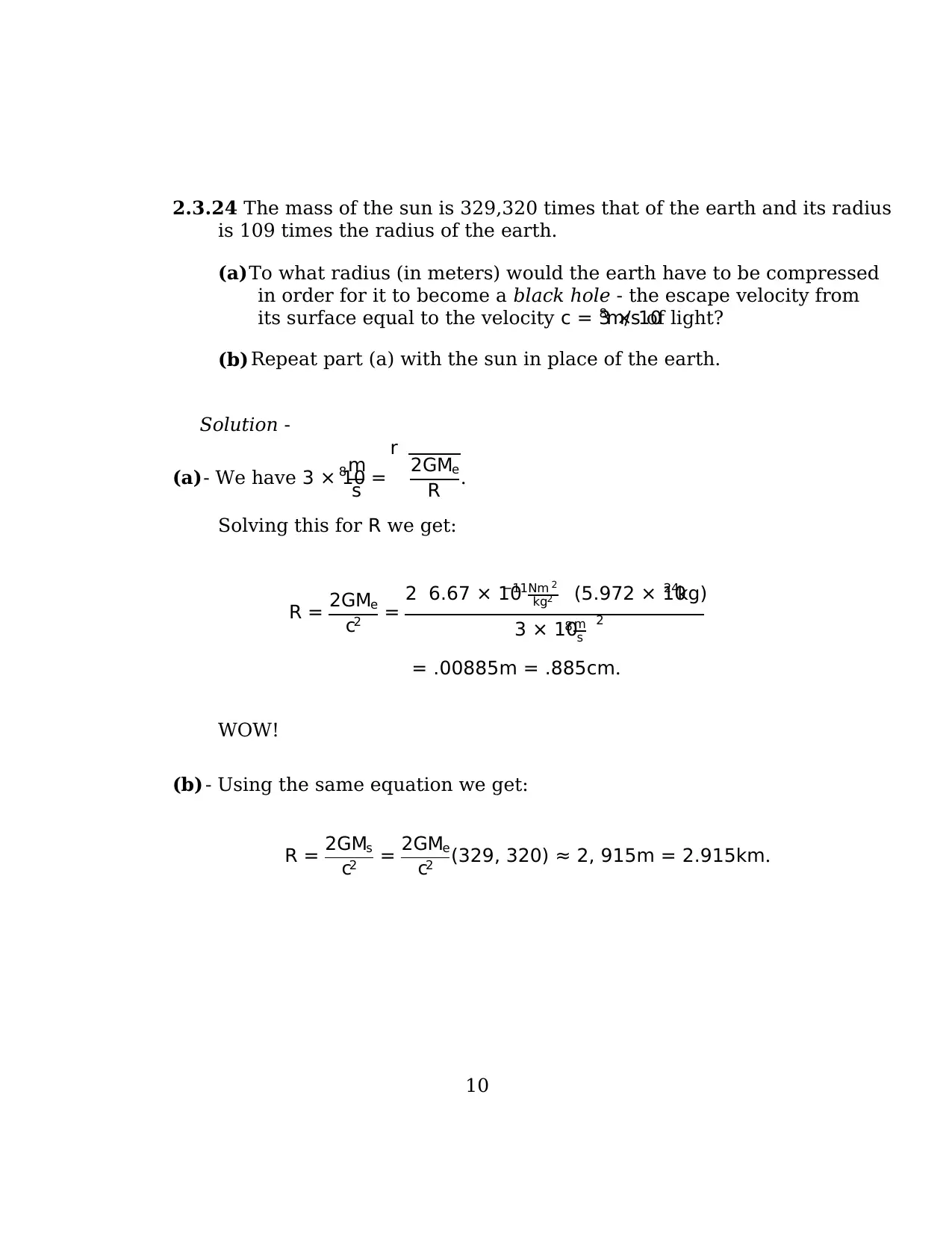
2.3.24 The mass of the sun is 329,320 times that of the earth and its radius
is 109 times the radius of the earth.
(a)To what radius (in meters) would the earth have to be compressed
in order for it to become a black hole - the escape velocity from
its surface equal to the velocity c = 3 × 108m/s of light?
(b) Repeat part (a) with the sun in place of the earth.
Solution -
(a)- We have 3 × 108 m
s =
r 2GMe
R .
Solving this for R we get:
R = 2GMe
c2 =
2 6.67 × 10−11Nm 2
kg2 (5.972 × 1024kg)
3 × 108 m
s
2
= .00885m = .885cm.
WOW!
(b) - Using the same equation we get:
R = 2GMs
c2 = 2GMe
c2 (329, 320) ≈ 2, 915m = 2.915km.
10
is 109 times the radius of the earth.
(a)To what radius (in meters) would the earth have to be compressed
in order for it to become a black hole - the escape velocity from
its surface equal to the velocity c = 3 × 108m/s of light?
(b) Repeat part (a) with the sun in place of the earth.
Solution -
(a)- We have 3 × 108 m
s =
r 2GMe
R .
Solving this for R we get:
R = 2GMe
c2 =
2 6.67 × 10−11Nm 2
kg2 (5.972 × 1024kg)
3 × 108 m
s
2
= .00885m = .885cm.
WOW!
(b) - Using the same equation we get:
R = 2GMs
c2 = 2GMe
c2 (329, 320) ≈ 2, 915m = 2.915km.
10
Paraphrase This Document
Need a fresh take? Get an instant paraphrase of this document with our AI Paraphraser
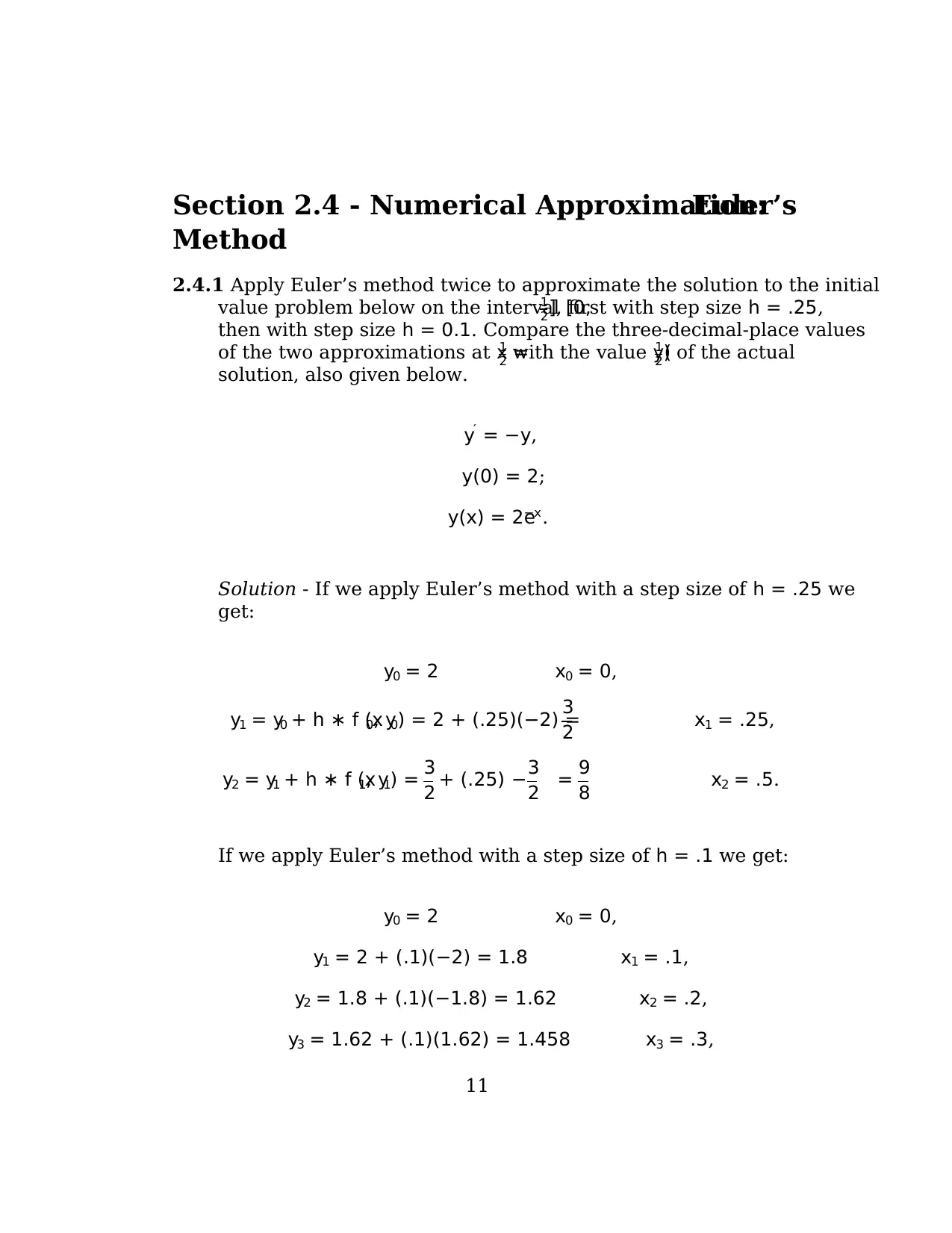
Section 2.4 - Numerical Approximation:Euler’s
Method
2.4.1 Apply Euler’s method twice to approximate the solution to the initial
value problem below on the interval [0,1
2], first with step size h = .25,
then with step size h = 0.1. Compare the three-decimal-place values
of the two approximations at x =1
2 with the value y(1
2) of the actual
solution, also given below.
y′ = −y,
y(0) = 2;
y(x) = 2e−x.
Solution - If we apply Euler’s method with a step size of h = .25 we
get:
y0 = 2 x0 = 0,
y1 = y0 + h ∗ f (x0, y0) = 2 + (.25)(−2) =
3
2 x1 = .25,
y2 = y1 + h ∗ f (x1, y1) = 3
2 + (.25) −3
2 = 9
8 x2 = .5.
If we apply Euler’s method with a step size of h = .1 we get:
y0 = 2 x0 = 0,
y1 = 2 + (.1)(−2) = 1.8 x1 = .1,
y2 = 1.8 + (.1)(−1.8) = 1.62 x2 = .2,
y3 = 1.62 + (.1)(1.62) = 1.458 x3 = .3,
11
Method
2.4.1 Apply Euler’s method twice to approximate the solution to the initial
value problem below on the interval [0,1
2], first with step size h = .25,
then with step size h = 0.1. Compare the three-decimal-place values
of the two approximations at x =1
2 with the value y(1
2) of the actual
solution, also given below.
y′ = −y,
y(0) = 2;
y(x) = 2e−x.
Solution - If we apply Euler’s method with a step size of h = .25 we
get:
y0 = 2 x0 = 0,
y1 = y0 + h ∗ f (x0, y0) = 2 + (.25)(−2) =
3
2 x1 = .25,
y2 = y1 + h ∗ f (x1, y1) = 3
2 + (.25) −3
2 = 9
8 x2 = .5.
If we apply Euler’s method with a step size of h = .1 we get:
y0 = 2 x0 = 0,
y1 = 2 + (.1)(−2) = 1.8 x1 = .1,
y2 = 1.8 + (.1)(−1.8) = 1.62 x2 = .2,
y3 = 1.62 + (.1)(1.62) = 1.458 x3 = .3,
11
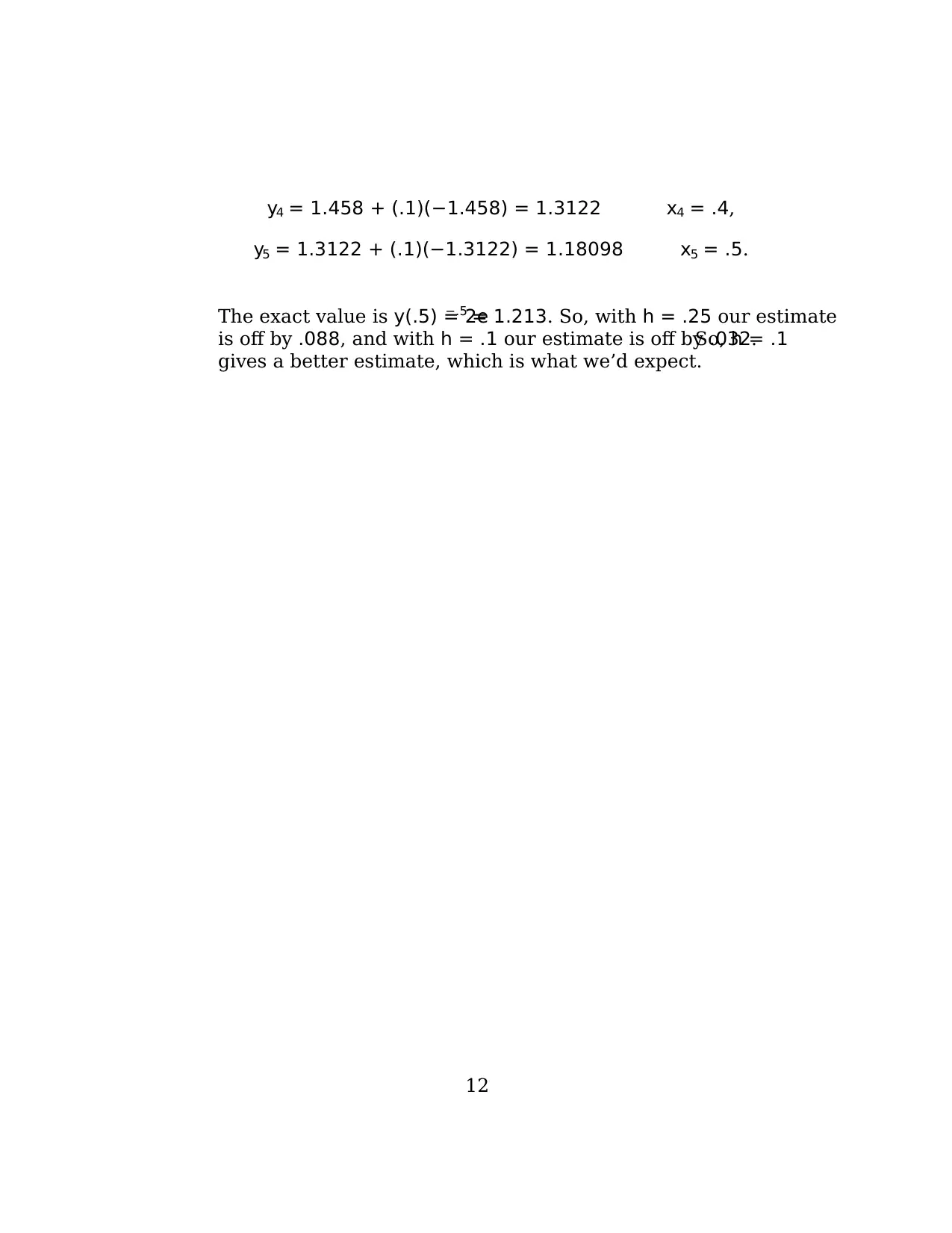
y4 = 1.458 + (.1)(−1.458) = 1.3122 x4 = .4,
y5 = 1.3122 + (.1)(−1.3122) = 1.18098 x5 = .5.
The exact value is y(.5) = 2e−.5 = 1.213. So, with h = .25 our estimate
is off by .088, and with h = .1 our estimate is off by .032.So, h = .1
gives a better estimate, which is what we’d expect.
12
y5 = 1.3122 + (.1)(−1.3122) = 1.18098 x5 = .5.
The exact value is y(.5) = 2e−.5 = 1.213. So, with h = .25 our estimate
is off by .088, and with h = .1 our estimate is off by .032.So, h = .1
gives a better estimate, which is what we’d expect.
12
⊘ This is a preview!⊘
Do you want full access?
Subscribe today to unlock all pages.

Trusted by 1+ million students worldwide
1 out of 19
Related Documents
Your All-in-One AI-Powered Toolkit for Academic Success.
+13062052269
info@desklib.com
Available 24*7 on WhatsApp / Email
![[object Object]](/_next/static/media/star-bottom.7253800d.svg)
Unlock your academic potential
Copyright © 2020–2025 A2Z Services. All Rights Reserved. Developed and managed by ZUCOL.





